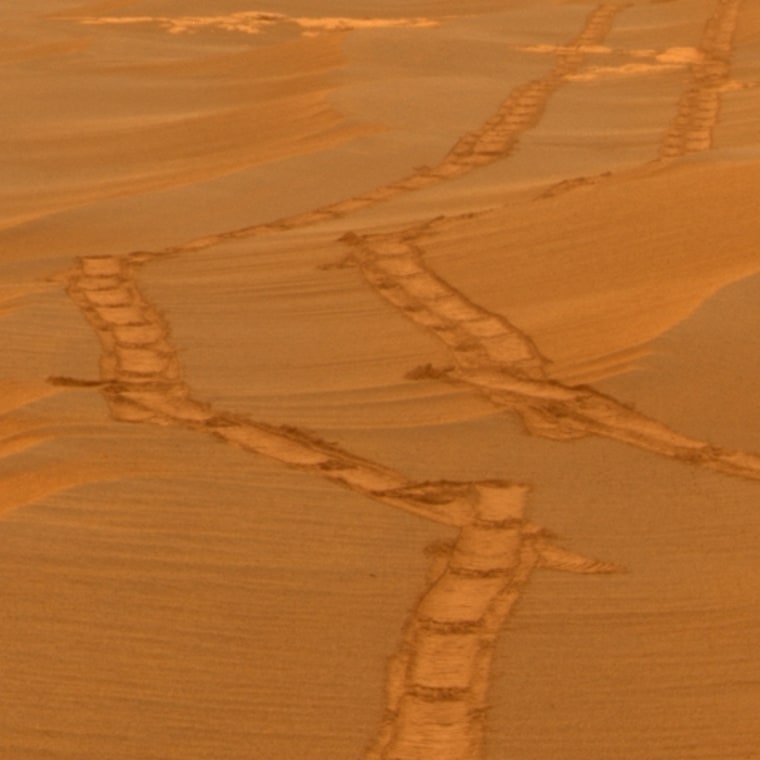NASA's long-lived twin Mars rovers Spirit and Opportunity have set a new endurance record on Mars, with Opportunity hot on the heels of its sister robot for the title of longest-running mission on the Martian surface.
Opportunity on Thursday matched the Mars mission lifespan of NASA's iconic Viking 1 lander, which spent six years and 116 days (for a total of 2,245 days) working on the Red Planet in the mid-1970s and early 80s.
If Opportunity survives three weeks longer than its older robotic twin Spirit, which has been silent for weeks but may actually be hibernating, the rover will take the all-time record for the longest mission on Mars. The two solar-powered rovers experienced their fourth Martian winter solstice — the day with the least amount of sunlight at their respective spots on Mars — on May 12.
"Opportunity, and likely Spirit, surpassing the Viking Lander 1 longevity record is truly remarkable, considering these rovers were designed for only a 90-day mission on the surface of Mars," John Callas, NASA's rover mission project manager at the Jet Propulsion Laboratory in Pasadena, Calif., said in a statement. "Passing the solstice means we're over the hump for the cold, dark, winter season."
Opportunity and Spirit were initially slated for missions lasting only 90 Martian days to explore the geology and chemistry of their respective landing sites. But they blew past those deadlines and have continued their missions for far longer than NASA engineers ever thought possible.
In January of this year, they each celebrated their sixth anniversary on Mars. That means right now both rovers are in the midst of their seventh Earth year exploring the Red Planet.
Spirit still silent
Spirit touched down on the surface of Mars ahead of Opportunity, but fell silent on March 22 of this year when it skipped a planned communications session with controllers on Earth.
The beleaguered Spirit rover has been out of communication for weeks after entering a low-power hibernation mode. The hibernation strategy was put in place when winter set in, temperatures dropped and the sun dipped in the sky. That combination left Spirit with insufficient power for its full range of functions.
The rover may wake up with the arrival of the Martian spring, and if so, will keep its hold on the record for the longest mission.
Spirit landed on Mars on Jan. 3, 2004, while Opportunity touched down on Jan. 25 (Eastern time) of that year. So Opportunity would have to survive at least 22 days longer than its twin to take the Martian mission title.
Because Spirit is out of contact, mission managers may not know for several weeks whether or not it survived and was still in operation on its record-setting day.
Opportunity, which is doing fine, breezed past Viking 1's 2,245-day record with no problems. The rover also hit another milestone in March, passing the 20-kilometer (12.43-mile) mark.
Mars orbiters are longer-lived
While Opportunity could swipe the Mars surface mission record from Spirit, it has a long way to go to take the title for the longest mission in the Martian neighborhood.
The current record for any mission to Mars, nine years, is held by NASA's late Mars Global Surveyor, which studied the planet between 1997 and 2006. NASA's Mars Odyssey orbiter has been studying Mars since 2001 — longer than any mission currently under way — and could take the longest-ever mantle away from the Mars rovers later this year, NASA mission managers said.
Opportunity has been steadily roving toward a huge Mars crater called Endeavour since mid-2008, when it finished its last crater pit stop Victoria Crater. Photos from the rover show the rim of Endeavour in the distance with vast plains of Martian sand etched with ripplelike dunes.
"The ripples look like waves on the ocean, like we're out in the middle of the ocean with land on the horizon, our destination," said rover principal investigator Steve Squyres of Cornell University. "Even though we know we might never get there, Endeavour is the goal that drives our exploration."
Photos of Endeavour Crater from spacecraft orbiting Mars have revealed the tantalizing fact that clay minerals are exposed at the crater. Scientists have not yet had a chance to examine such minerals on the surface in the more than six years Opportunity and Spirit have been on Mars.
"Those minerals form under wet conditions more neutral than the wet, acidic environment that formed the sulfates we've found with Opportunity," Squyres said. "The clay minerals at Endeavour speak to a time when the chemistry was much friendlier to life than the environments that formed the minerals Opportunity has seen so far. We want to get there to learn their context. Was there flowing water? Were there steam vents? Hot springs? We want to find out."
